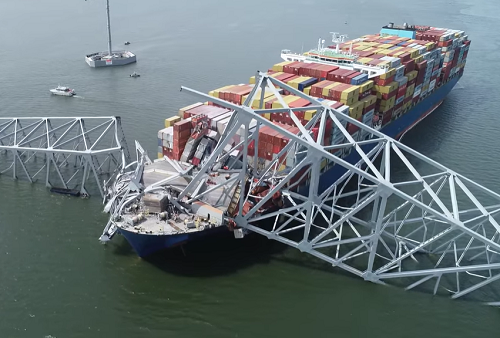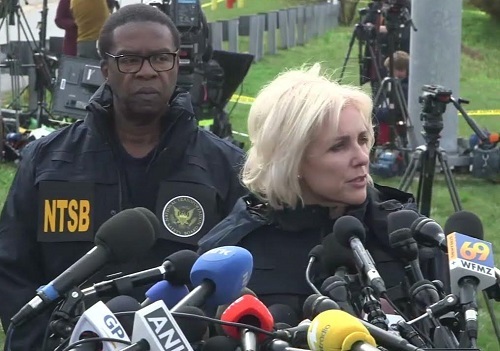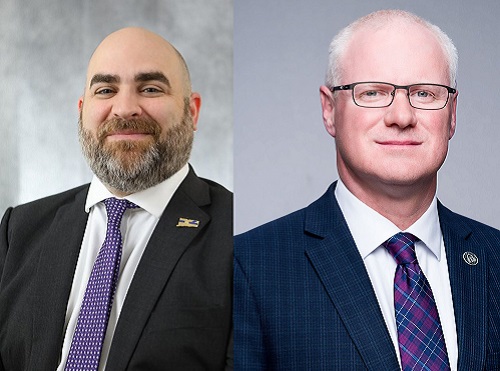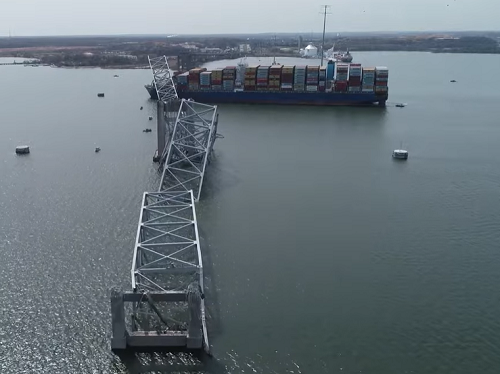Multiple federal and state agencies are gearing up for a mammoth recovery project after a container ship strike collapsed major sections of the 1.6-mile-long Francis Scott Key Bridge outside Baltimore.
[Above photo by the NTSB]
On March 26, the nearly 1,000-foot-long Singapore-flagged container ship Dali reportedly lost power while sailing out of Baltimore Harbor and subsequently struck the Francis Scott Key Bridge, where the I-695 “Baltimore Beltway” crosses over the Patapsco River; the main entry point to the Port of Baltimore.

The resulting bridge collapse led to the deaths of six highway workers making pavement repairs on the bridge at the time and blocked the key waterway for maritime traffic – forcing the suspension of all port operations.
The loss of lives could have been greater if not for the quick action of three Maryland Transportation Authority police officers.
Upon receiving the relayed mayday call from the container ship, they immediately blocked motor vehicle access to the bridge.

[Editor’s note: Those officers – Sergeant Paul Pastorek, Corporal Jeremy Herbert, and Officer Garry Kirts – were honored during a special on-field ceremony during the third inning of the Baltimore Orioles opening day baseball game on March 28 at Baltimore’s Camden Yards stadium.]
The suspension of Baltimore port operations has critical economic consequences as it is a major nation and international freight hub. The port handled more than 444,000 passengers and 52.3 million tons of foreign cargo valued at $80 billion in 2023 – including 750,000 automobiles.
Thus reopening the shipping passage for the port has become a key goal for President Biden.
“I’ve directed my team to move heaven and earth to reopen the port and rebuild the bridge as soon as humanly possible,” the president stressed in a brief press event on March 26. “The port of Baltimore is one of the nation’s largest shipping hubs. It’s also the top port in America for both imports and exports of automobiles and light trucks … and we’re going to get it up and running again as soon as possible.”
He added that the bridge is also critical for travel, not just for Baltimore but for the Northeast Corridor.

“Over 30,000 vehicles cross the Francis Scott Key Bridge on a daily basis,” President Biden noted. “It’s one of the most important elements for the economy in the Northeast and the quality of life. So it’s my intention that federal government will pay for the entire cost of reconstructing that bridge.”
The president also said the U.S. Army Corps of Engineers will lead the effort to clear the channel of bridge wreckage so ship traffic into and out of Baltimore can resume.
Following an emergency request from Maryland Governor Wes Moore (D) and the Maryland Department of Transportation on March 28, the Federal Highway Administration issued $60 million in “quick release” Emergency Relief funds to pay for initial mobilization, operations, and debris recovery from the collapse of the Francis Scott Key Bridge.
“[These] federal emergency funds will help Maryland begin urgent work, to be followed by further resources as recovery and rebuilding efforts progress,” noted Pete Buttigieg, secretary of the U.S. Department of Transportation, in a statement.

“President Biden has been clear: The federal government will do everything it takes to help rebuild the bridge and get the Port of Baltimore back open,” he added
Gov. Moore noted in a separate statement that this emergency relief funding is not related to bridge reconstruction efforts as Maryland is currently working to develop the preliminary scope and engineering estimate of future financial needs for that rebuilding effort.
The governor also pointed out that recovery operations are “vital” to reopen the shipping channel and address the needs of the region’s transportation system.
“The collapse of the bridge is not just a Maryland crisis; it is a global crisis, because the nation’s economy and the world’s economy depends on the port of Baltimore,” he said in a press conference on March 27.

“[We are] mobilizing major resources all around to be able to make sure that we are getting things moving and this has happened at record speed,” Gov. Moore noted. “With the Maryland Department of Transportation and my executive team, we are going to continue to mobilize assets at all levels of government and society.”
He added that, “at this point,” he does not know what the total costs are going to be to clear the wreckage and replace the bridge, nor what the full timeline for that process will be.
“The task in front of us is daunting, but despite that, I can tell you right now our resolve is unshaken,” he stressed. “We will get to completion. It will take time, but we will do it together and we are going to make sure that we leave no one behind.”
Meanwhile, the National Transportation Safety Board has deployed a “go team” to the Francis Scott Key Bridge to start investigating the bridge collapse incident.

That team includes experts in modal operations and bridge infrastructure, noted NTSB Chair Jennifer Homendy during a press conference on March 28, and that team is now collecting information of the cargo ship itself, its safety history, and other details pertaining to vessel operation.
The NTSB is also collecting information about the bridge structure itself, and Homendy noted in her remarks that the bridge was in satisfactory condition, based on the most recent inspection of the span conducted in May 2023.
Meanwhile, the Maryland State Highway Administration – a division of the Maryland DOT – has created a series of detours to help re-route motor vehicle traffic away from the collapsed bridge.
“This is a shocking and tragic event for not just the state of Maryland, but for the nation and transportation community as a whole,” noted Jim Tymon, executive director of the American Association of State Highway and Transportation Officials.
“AASHTO and its members express their condolences to the victims and their loved ones as we keep them in our thoughts,” he added. “We also extend our support and appreciation to the first responders as they focus on recovery operations and the Maryland DOT as they work to keep traffic moving around the region and restore access to the port.”
 Top Stories
Top Stories
New AASHTO Leadership Elected at Annual Meeting
November 1, 2024 Top Stories
Top Stories

